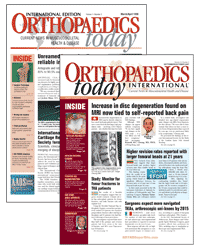Orthopaedics Today International: 10 years and still going strong
I confess that when I was invited to join the editorial board of Orthopaedics Today International in 1998, I felt uncertain as to the future viability of the new Slack Incorporated project.

After working for many years on the British volume of the Journal of Bone and Joint Surgery, a more traditional medical journal, the concept of a “medical newspaper” felt very alien to me. The content would represent new ideas and innovations without supporting data from long term follow-up. The writing would, out of necessity, be much tighter and the stories shorter to ensure broad coverage over a wide range of specialties. Would the orthopaedic surgeon read it?
A truly global medium
Ten years later, my fears have been shown to be unfounded and Orthopaedics Today International continues to go from strength to strength. The publication has an expanding worldwide readership and now reports material from all the major international orthopaedic meetings.
In addition to the scientific coverage, we are able to report on medico-political affairs that affect the way orthopaedic surgeons are trained and practice. Other changes have seen the introduction of more instructional material based on virtual interactive discussion between experts from different countries. We are no longer so reliant on material from North America, but still exchange and publish important new information in both this publication and Orthopedics Today (the U.S. edition).
Emerging areas of study
|
Looking back to our first few issues in 1998 and what were considered some of the “hot topics” of the day, I am surprised that so many of the featured topics back then went on to have successful outcomes. Many research endeavors in 1998, particularly in the fields of biomaterials and biologics, reported further advances in the intervening years, but the principles remain sound. Some techniques, such as robotic-aided surgery and cartilage cell grafting, are still evolving and have been the subject of articles in recent issues.
I also noted with interest that two stories — the first appearing in the inaugural issue in 1998 and the second appearing in the issue you now hold in your hands — deal with the need for improving classification systems for open fractures in predicting limb viability. Speed of publication has also allowed us to alert surgeons to failing concepts, such as the precoated femoral stem and the 3M Capital Hip.
Looking ahead
Where do we go next? We would like to increase our news coverage in Asia, Latin America and Eastern Europe. We also need to improve links with our partners in the orthopaedic manufacturing industry to ensure that we are alerted to new developments as they emerge.
At the same time, we welcome far more feedback from our readership on what you would like to see in Orthopaedics Today International for the next 10 years. Please tell us — it is your paper!
For more information:
- David L. Hamblen, PhD, FRCS, is professor emeritus at the University of Glasgow and is the consulting editor for Orthopaedics Today International.

